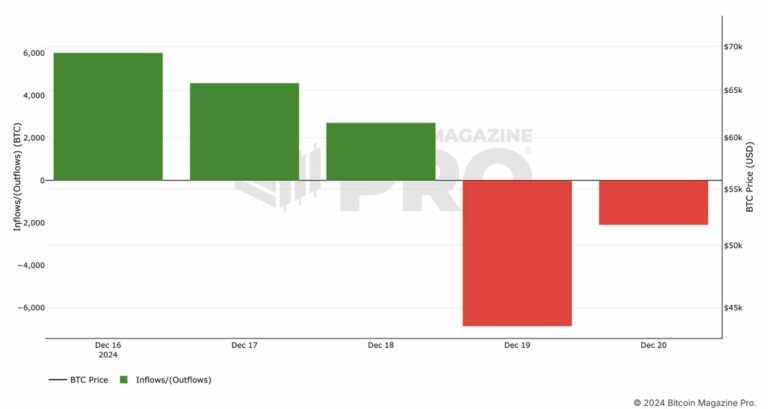The level of demand for Bitcoin by institutional investors through spot Bitcoin ETFs is reported to have doubled miners’ production, leading to a liquidity squeeze and price sensitivity. An analyst has predicted that Bitcoin could witness more liquidation if the price falls below the $90k level.
The significant demand for Bitcoin (BTC) by institutional investors via spot BTC Exchange Traded Fund (ETF) is reported to have escalated recently, raising concerns about the ability of miners to adequately reset the market into a state of equilibrium. According to market data, spot BTC ETFs recorded an inflow of $423.6 million (4,349.7 BTC) in the past week, almost doubling the 2,250 BTC mined within the same period.


Reports also indicate that spot BTC inflows reached a staggering amount of $5.5 billion, illustrating the unprecedented institutional demand in the face of recent liquidity. Delving into the historical data, we observed a $817.5 million ETF inflow was recorded in the second week of November. At that time, Bitcoin had declined by 3% to trade at $86,855. CNF confirmed that BlackRock’s IBIT led this flow with $778.3 million, followed by Fidelity’s FBTC, which added $37.2 million within the week.
According to analysts, the mismatch between ETF inflow and miners’ production has significantly led to a liquidity squeeze, which subjects the asset to price sensitivity. On the positive side, a continuous demand by institutional investors in relation to the declining miners’ production would position the Bitcoin price at a massive upsurge. Conversely, the price could massively decline if institutions offload a chunk of this concentration.
Bitcoin Mining Revenue and Profit Decline
Analyzing the reasons for this imbalance, we observed a 2% decline in daily block reward gross profit in October. According to JPMorgan research, miners earned $41,800 per hour per second (EH/s) in daily block reward revenue. In the third quarter of 2024 (Q3 2024), the third largest Bitcoin mining company on Wall Street Riot Platforms also recorded a massive loss in revenue.
Specifically, the loss increased to $154.4 million from the $80 million recorded in the same period last year. The reason was linked to the cost of mining one Bitcoin, which stood at $35,376. Other experts have attributed this to the Bitcoin halving event in April, which saw the mining reward cut by half, coupled with the rising network difficulty and the massive reduction in power credits. Fascinatingly, the CEO of Riot, Jason Les, commented on the positive side:
Riot recorded $84.8 million in revenue this quarter, representing a 65% increase over the same quarter in 2023, driven by a 159% year-over-year increase in deployed hash rate to 28 EH/s. This significant increase in deployed hash rate allowed us to produce 1,104 Bitcoin this quarter, in line with our Bitcoin production in the third quarter of 2023..
At press time, Bitcoin was trading at $95.9k after declining by 8% in the last seven days. According to Rekt Capital, Bitcoin has shown signs of transitioning into a multi-week correction. Per his observation, week eight of the Bitcoin price recovery usually becomes a corrective one. Meanwhile, week nine followed a similar trend in 2017, but to a lesser degree.
Historically, Week 8 in #BTC Price Discovery tends to be a corrective week
In 2017, Week 9 was also corrective but to a much lesser extent than Week 8.
Generally, once BTC clears the typically corrective Weeks 7 and 8 – the retrace gets close to a bottom$BTC #Crypto #Bitcoin https://t.co/KRQrbdJagz— Rekt Capital (@rektcapital) December 23, 2024
Director of trading at liquidity provider Arbelos Markets Sean McNulty also believes that the asset could see more liquidation if it breaks below the $90k level.
Buy Bitcoin GuideBitcoin Wallet TutorialCheck 24-hour Bitcoin PriceMore Bitcoin NewsWhat is Bitcoin?






